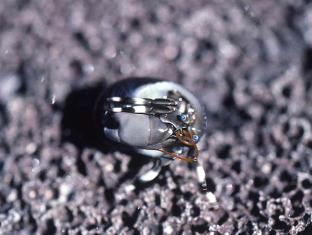Published in the Ocean Watch column, Honolulu Star-Advertiser © Susan Scott
February 21, 2011
 My recent column about playing with hermit crabs in Oahu tide pools generated e-mail that kept me busy for days.
My recent column about playing with hermit crabs in Oahu tide pools generated e-mail that kept me busy for days.
One note came from reader Janice Crowl: “Your article brought back memories of when I was a child in Ewa Beach. Hermits were fun to watch and play with. One of my favorite books was ‘Pagoo’!”
Janice wrote as if I knew this book, and when I looked it up, I discovered I should know this book. The excerpts and reviews of this 1957 still-in-print story, by Holling C. Holling (1900-1973), were so good, I bought a copy.
“Pagoo” is the timeless tale of a hermit crab’s life. To this day, teachers and parents read this engaging book to their students and children. I’m sure they do so with pleasure. Holling wrote the marine biology in such fun terms that adults can enjoy it as much as kids.
Pagoo is short for Pagurus, a genus of hermit crabs containing 170 or more species worldwide (none in Hawaii, but we have several close relatives). Holling, who consulted with scientists from Scripps, Cal Tech and the University of California, Santa Cruz, among others, painted marine life in words and illustrations (he and his wife were artists) that leap from the pages. It took me several evenings to read this 86-page book because I didn’t want to miss one twitch of a feeler — Holling’s term for the crab’s antenna.
The story starts with Pagoo as a tiny speck of life no bigger than a pencil dot. He discovers he’s adrift in the ocean, which from his point of view is a huge kettle of soup containing delicious algae salad with the occasional meatball, and salted just right.
Among Pagoo’s many adventures are his encounters with other creatures that also live in the soup. Some animals imitate flowers (anemones). There are slender palms with waving plumes (hydroids). And the Witch of Deep Hole (an octopus) carries magic wands (tentacles), their undersides covered with white donuts (suckers).
Pagoo’s quest as he grows is to find the perfect shell home. But “Houses Are Scarce in Tide Pool Town” (the title of Chapter 10), and the search proves difficult.
I wondered whether I was correct in assuming that empty snail shells were the main factor limiting hermit crab populations, but I wonder no more. A biologist friend happened to be teaching hermit crab biology at Hawaii Pacific University when my column came out, and he e-mailed me two classic studies from 1972 and 1981 regarding hermit crabs.
In the first, University of Washington researchers, over a one-year period, added 12,000 empty snail shells to an isolated intertidal reef of an island in Puget Sound. (Pagoo would have been delirious. The shells were those generally used by Pagurus species.) The result was as I suspected. There was a significant increase in the Pagurus population.
Did the hermit crabs fight for the new shells?
Yes, according to the second hermit crab study, conducted by Smithsonian biologists in Panama. When the researchers added empty intact shells to the tide pools, hermit crabs fought for them, but never naked and only when in need. Those living in shells too small attacked crabs smaller than themselves that had claimed the large, intact shells. Seems fair enough.
My biologist friend also sent me photos of four common tide pool hermit crabs (genus Calcinus) that he uses in class. I only knew three. Now, every time I pass a tide pool, I stop and search for a little green crab with hairy legs. Its common name is the hairy hermit crab. When I find one, though, I’ll call it Pagoo.